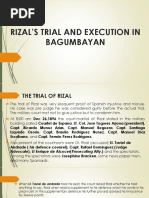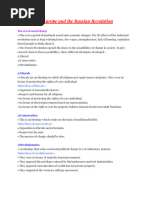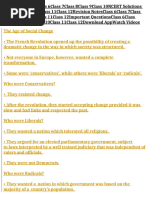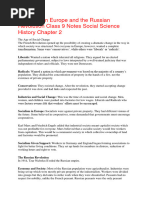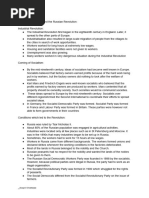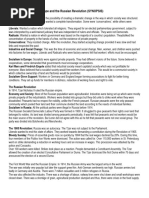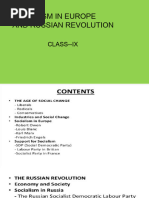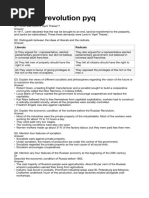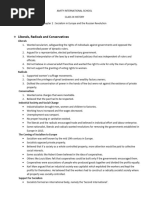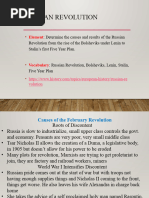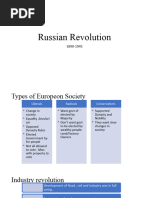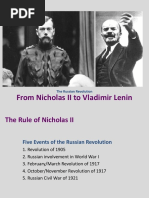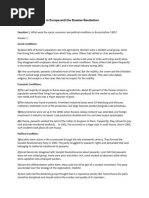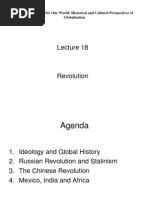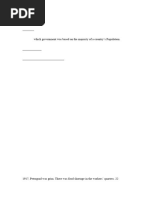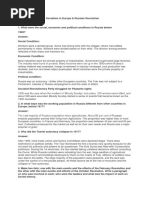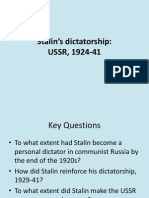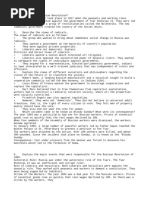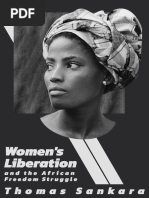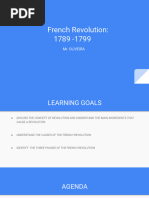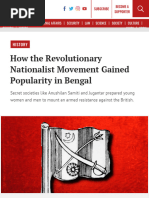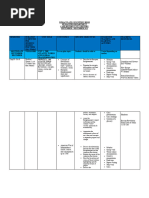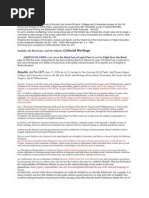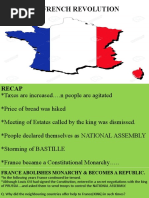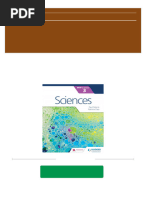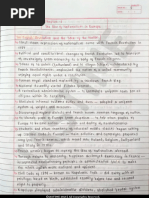0 ratings0% found this document useful (0 votes)
16 viewsSocialism in Europe and Russian Revolution Class 9
Socialism in Europe and Russian Revolution Class 9
Uploaded by
nithinvenkatesh5119Copyright:
© All Rights Reserved
Available Formats
Download as PDF, TXT or read online from Scribd
Socialism in Europe and Russian Revolution Class 9
Socialism in Europe and Russian Revolution Class 9
Uploaded by
nithinvenkatesh51190 ratings0% found this document useful (0 votes)
16 views7 pagesOriginal Title
null (1)
Copyright
© © All Rights Reserved
Available Formats
PDF, TXT or read online from Scribd
Share this document
Did you find this document useful?
Is this content inappropriate?
Copyright:
© All Rights Reserved
Available Formats
Download as PDF, TXT or read online from Scribd
Download as pdf or txt
0 ratings0% found this document useful (0 votes)
16 views7 pagesSocialism in Europe and Russian Revolution Class 9
Socialism in Europe and Russian Revolution Class 9
Uploaded by
nithinvenkatesh5119Copyright:
© All Rights Reserved
Available Formats
Download as PDF, TXT or read online from Scribd
Download as pdf or txt
You are on page 1of 7
Socialism in Europe and Russian Revolution
Class 9
The Age of Social Change (Part 1):
Giuseppe Mazzini (1815):
• An Italian nationalist.
• Asked other Italians to achieve democracy in Italy.
• His writings were also read by Indians.
Robert Owen (1771 – 1858):
• A big English manufacturer.
• Owner of New Harmony (USA).
Louis Blanc (1813 – 1882), Karl Marx (1818 –
1883) and Friedrich Engels (1820 – 1895):
• Capitalist – capitalists are those who hold share in a
factory.
• Profit of the capitalist were produced by the workers.
• Working conditions were poor.
• Working hours were long.
• Wanted to control all private property by a socialist
society where it is socially controlled.
• One said “A communist society was the natural society
of the future”.
Note:
Parties:
• In Germany – Social Democratic Party (SPD)
• In Britain (1905) – Trade Unionist Formed Labours Party
• In France (1905) – Socialist Party
• Up to 1914, socialist was not successful in forming a
government in Europe.
The Russian Revolution (Part 2):
• In 1914, Tsar Nicholas 2 is the king of Russia and its
empire.
• Russian empire includes Moscow, current day Finland,
Latina, Lithuania, Estonia, parts of Poland, Ukraine and
Belarus. It stretches till Pacific and Central Asian states
Georgia and Azerbaijan.
• The government of Russia is called Duma.
• Prominent industrial areas were St. Petersburg and
Moscow.
• Craftsmen took more place in production.
• Women were 31 percent in factory by 1914.
• Women were paid lesser than that of men (about half or
three quarter).
• Many factories were set up in 1890s.
• Railways extended and foreign investment increased.
• In craft units and small workshops, the working hour is
about 5 hours but in big factories they were 10 – 12
hours.
• Factory inspectors were set up by government, but they
couldn’t prevent minimum wages and limited working
hours.
• In factories workers stayed in rooms and by 1914 they
lived in dormitories.
• The workers couldn’t keep their family with them.
• Workers were sleeping in shifts.
• The metal factory workers of St. Petersburg once said
“The metal workers thought them as aristocrats and their
occupation needed more training and skills”.
• The division of labours showed them by their dresses.
• Some workers formed association to help members in
their time of unemployed and financial support.
• Strikes took place in industry during 1896 – 1897 and in
metal industry in 1902.
• The Russian peasants wanted the land of nobles.
• They even refused to pay rents and they even killed their
land lords.
• In 1902, this was being done largely on South Russia.
• In 1905, this took place all over Russia.
• Russian peasants were different from European peasant
in many different ways.
• Peasants joined all their land periodically and divide their
lands according to their family needs.
The February Revolution in Petrograd (Part
3):
• Workers in quarters met a food shortage.
• The workers made a strike in a factory in 23rd February,
1917.
• The next day workers of fifty factories called a strike in
sympathy.
• Women also came for this strike.
• This became the International Women’s Day on 23rd
February.
• Tsar Nicholas 2 dismissed the third Duma on 25th
February.
• Tsar first ordered cavalry to keep an eye on them.
• 26th February was when the demonstrators came again.
• The cavalry refused and joined with the demonstrators.
• The soldiers and workers formed Soviet.
• On 2nd March Tsar Nocholas 2 was asked to abdicate his
throne by army officials.
• The Provisional Government formed.
• Restrictions were everywhere.
• Soviets were everywhere.
• Vladmir Lenin returned from his exile.
• Vladmir Lenin formed the Bolshevik Party.
• The Bolshevik was renamed as Communist Party.
• Vladmir demanded 3 things known as the April Theses.
• The “April Theses” were
I. Banks to be nationalised.
II. Lands to be transferred to peasants.
III. And to end the war.
• The Bolshevik Party influence grew and Provisional
Government reduced. This made a conflict between
Bolshevik and Provisional Government.
• In result to this Lenin gathered Soviets and Bolsheviks
and made them protest against Provisional Government.
• And in result “Military Revolutionary Committee” was
formed by Lenin.
• Lenin made Leon Trotskii as the leaded of Military
Revolutionary Committee.
• At this time Kerensky was the Prime Minister of Russia.
He guessed something was wrong and asked military to
protect Winter Palace.
• Military Revolutionary Committee took a ship aurora
and shelled at Winter Palace. Other vessels were at the
parts of river Neva. Other Bolshevik members caught the
other ministers.
• Now the city was in hands of Bolshevik.
What changed after October? (Part 4):
• Many banks and industries were nationalised.
• Bolsheviks opposed social property.
• They allowed peasants to seize the property of nobility.
• The houses were divided according to the family needs.
• A dressing competition was held in 1918.
• In this competition, (budeonovka) the soviet hat was
chosen.
• Bolshevik party was renamed as Russian Communist
Party.
• In November 1917, Bolsheviks conducted election.
• The Bolsheviks lose the election and Social
Revolutionary Party won.
• Bolsheviks dismissed them and said they won in unfair
conditions.
• Bolsheviks said All Russian Congress of Soviet was
more liberal.
• In March 1918, Bolsheviks made peace with Germany
and Brest Litovsk.
• Russia was made one Party state.
• Bolsheviks had secret police called cheka laterly called
as OGPU and NKVD.
• NKVD and OGPU punished who criticised Bolshevik
Party.
• The Russian army started to break up.
• Soldiers were mostly peasants.
• Soldiers like to move to their native and farm the land
which they got from redistribution.
• The reds were Bolshevik, greens were Non-Bolshevik
Socialist and whites were Pro Tsarists.
• Green and white opposed red.
• Red has people support.
• Green and white got support from Japanese, Americans
and British.
• Green and white ruled many parts in Russia.
• Reds ruled full Russia in January 1920.
• After the death of Lenin, Stalin took the power and ruled
the country.
• He introduced collectivisation.
• In this collectivisation, the lands were collected and
distributed. The Bolsheviks officials supervised them.
The peasants should work in land and were paid low.
• The price of grains was fixed by government.
• Because of the collectivisation, many peasants killed
their cattle.
• Russia met a famine during 1930-1933 in which 4
million peoples died.
• Between 1929 to 1931, the amount of cattle fell by one
third.
• The collective farming is also called as Kolkborg.
• The peasants were allowed to independently cultivate but
they were treated unsympathetically.
• The people who oppose collectivisation were exiled.
• By 1939, over 2 million were in prison or labour camps.
• Most of the prisoners were innocent but nobody spoke
for them.
• Many of them were forced to make false confessions
under torture and were executed.
• Bolsheviks introduced first five years plan.
• The first 2 of the five years plan were during 1927-1932
and 1933-1938.
• Industrial production increased by 100 percent between
1929 and 1933.
The Global Influence of the Russian
Revolution and the USSR Part 5):
• Bolsheviks held a conference in eastern parts of Russia
in 1920.
• Many non-Russians participated in this conference.
• For representing India Jawaharlal Nehru and
Rabindranath Tagore were in the conference.
• Bolsheviks founded an International Union of Pro-
Bolshevik Socialist Parties.
• Some of them received education in USSR’s Communist
University of the workers.
• The first five years plan introduced in Russia and now
many countries follow that including India.
You might also like
- A Level History Revision PDFDocument58 pagesA Level History Revision PDFFegason Fegy100% (3)
- Chapter 7 - Nationalism - Born in Blood and Fire - A Concise History of Latin America, 3e - W. W. Norton StudySpaceDocument8 pagesChapter 7 - Nationalism - Born in Blood and Fire - A Concise History of Latin America, 3e - W. W. Norton StudySpacedilarahekimci100% (1)
- Great LeadersDocument12 pagesGreat LeadersWensore CambiaNo ratings yet
- Land Survey of The Phils.Document5 pagesLand Survey of The Phils.Donna Serrano-De JesusNo ratings yet
- Rizal's Trial and Execution in BagumbayanDocument12 pagesRizal's Trial and Execution in BagumbayanJamella Madora75% (4)
- Class 9th sst revision NotesDocument5 pagesClass 9th sst revision Notesmsoni4857No ratings yet
- Class 9th History Chapter 2nd NotesDocument6 pagesClass 9th History Chapter 2nd Notesrinku varshneyNo ratings yet
- The Russian RevolutionDocument33 pagesThe Russian RevolutionAnita Pant100% (1)
- Socialism and The Russian RevolutionDocument7 pagesSocialism and The Russian Revolutionvedanshjha000No ratings yet
- Socialism in Europe and the Russian RevolutionDocument8 pagesSocialism in Europe and the Russian Revolutionbeenadinesh29No ratings yet
- Chapter 2 HistoryDocument9 pagesChapter 2 HistoryAbhilasha PuhanNo ratings yet
- Socialism in Europe and The Russian Revolution Class 9 Notes Social Science History Chapter 2Document4 pagesSocialism in Europe and The Russian Revolution Class 9 Notes Social Science History Chapter 2e834439No ratings yet
- The Russian Revolution - Short NotesDocument5 pagesThe Russian Revolution - Short Notesinstantmaggie6No ratings yet
- ASG202411172025276048_0_167Document4 pagesASG202411172025276048_0_167Harshit RajNo ratings yet
- GRADE-9 Socialism in Europe and The Russian Revolution (SYNOPSIS)Document3 pagesGRADE-9 Socialism in Europe and The Russian Revolution (SYNOPSIS)gadesowjanya7No ratings yet
- ASM_78501Document13 pagesASM_78501shaurya singhNo ratings yet
- Key Notes-Russian Revolution 2Document3 pagesKey Notes-Russian Revolution 2komal thawaniNo ratings yet
- Presentation 1Document14 pagesPresentation 1divyanshyadav18809No ratings yet
- Socialism in Europe and Rin Russia Ix STDDocument29 pagesSocialism in Europe and Rin Russia Ix STDgy gyNo ratings yet
- Socialism And-Wps OfficeDocument29 pagesSocialism And-Wps Officekanchangujral9No ratings yet
- Rusian revolution R SUB UNIT 3 notesDocument4 pagesRusian revolution R SUB UNIT 3 notesnairaadithpNo ratings yet
- Grade-9 Russian Revolution NotesDocument3 pagesGrade-9 Russian Revolution Notesgadesowjanya7No ratings yet
- Chapter-2 History Socialism in Europe and The Russian RevolutionDocument4 pagesChapter-2 History Socialism in Europe and The Russian RevolutionRohit YadavNo ratings yet
- Ix His L02 M02 Socialism in Europe and The Russian Revolution HandoutDocument5 pagesIx His L02 M02 Socialism in Europe and The Russian Revolution HandoutOshna MittalNo ratings yet
- Russian Revolution Pyq 2Document3 pagesRussian Revolution Pyq 2mauryaraj996No ratings yet
- RUSSIAN REVOLUTION HANDOUTDocument5 pagesRUSSIAN REVOLUTION HANDOUTTanishq ManglaNo ratings yet
- The Russian RevolutionDocument40 pagesThe Russian RevolutionSambit kumar MohapatraNo ratings yet
- 09 Social Science Key Notes History Ch2 Socialism in Europe and Russian RevolutionDocument4 pages09 Social Science Key Notes History Ch2 Socialism in Europe and Russian RevolutionManisha SinghNo ratings yet
- BolshevikDocument27 pagesBolshevikmadhvisonamNo ratings yet
- Russian RevolutionDocument37 pagesRussian Revolutionjuliana.bernardiNo ratings yet
- Russian RevolutionDocument7 pagesRussian Revolutionatharavjadhav812No ratings yet
- Soumen Mahapatra (29) 2. Achinta Choudhury (02) 3. Balai Hembram (07) 4. Akash Verma (03) 5. Balaram Mangal (08) 6. Soubhagya DeyDocument16 pagesSoumen Mahapatra (29) 2. Achinta Choudhury (02) 3. Balai Hembram (07) 4. Akash Verma (03) 5. Balaram Mangal (08) 6. Soubhagya DeyAMIT KUMAR PRADHANNo ratings yet
- Russian RevolutionDocument18 pagesRussian RevolutionAnuj KumarNo ratings yet
- Russian Revolution-30-35Document6 pagesRussian Revolution-30-35degob14762No ratings yet
- Chapter - 2 Socialism in Europe and The Russian RevolutionDocument24 pagesChapter - 2 Socialism in Europe and The Russian Revolutions00480691No ratings yet
- Nick II and LeninDocument58 pagesNick II and LeninSol Ines PerezNo ratings yet
- Socialism in Europe the Russian empire textbook exercisesDocument6 pagesSocialism in Europe the Russian empire textbook exercisesroshini0166No ratings yet
- Cbse Class 9 Social Science History Chapter 2 NotesDocument8 pagesCbse Class 9 Social Science History Chapter 2 Notesrajveerkumavat2010No ratings yet
- History 2Document7 pagesHistory 2ceoNo ratings yet
- AP/HUMA 1770 6.0A One World: Historical and Cultural Perspectives of GlobalizationDocument33 pagesAP/HUMA 1770 6.0A One World: Historical and Cultural Perspectives of GlobalizationElric KuNo ratings yet
- Socialism in Europe and The Russian RevolutionDocument7 pagesSocialism in Europe and The Russian Revolutionshreyashmaurya788No ratings yet
- class 9 history russian revolutionDocument8 pagesclass 9 history russian revolutionsavageitgirlNo ratings yet
- CBSE Class 9 History Chapter 2 Notes - Socialism in Europe and The Russian RevolutionDocument4 pagesCBSE Class 9 History Chapter 2 Notes - Socialism in Europe and The Russian RevolutionGaming with Shivangi and aadityaNo ratings yet
- Notes+Socialism+in+EuropeDocument4 pagesNotes+Socialism+in+EuropeLasar NadarNo ratings yet
- RUSSIADocument46 pagesRUSSIAmabongosibabalweNo ratings yet
- The Russian Revolution: Made by - Tridha IyerDocument19 pagesThe Russian Revolution: Made by - Tridha IyerThe Multi-Ninja GuyNo ratings yet
- STD 9 - History - Russian Revolution - Reading Material (NVS)Document20 pagesSTD 9 - History - Russian Revolution - Reading Material (NVS)khanyusra791No ratings yet
- NCERT Solutions RUSSIAN REVOLUTIONDocument16 pagesNCERT Solutions RUSSIAN REVOLUTIONgurushahi0001No ratings yet
- Russain Revolution NotesDocument5 pagesRussain Revolution NotesmskvijiNo ratings yet
- Stalin's Dictatorship: USSR, 1924-41Document35 pagesStalin's Dictatorship: USSR, 1924-41tlyskivnNo ratings yet
- Russian revolutionDocument8 pagesRussian revolutionNeeruNo ratings yet
- Communism and Capitalism TERM 1Document112 pagesCommunism and Capitalism TERM 1ciketlengNo ratings yet
- Lecture Notes Russian RevolutionDocument6 pagesLecture Notes Russian Revolutionhafiz_yaakopNo ratings yet
- Grade 9 Russian Revolution Important PointsDocument9 pagesGrade 9 Russian Revolution Important PointsAdeeba AbdullahNo ratings yet
- L-2 Socialism in Europe and Russian RevolutionDocument5 pagesL-2 Socialism in Europe and Russian RevolutionYeshwanth VukkurthyNo ratings yet
- Socialism in Europe and The Russian RevolutionDocument4 pagesSocialism in Europe and The Russian Revolutionutkarshastronaut2468No ratings yet
- Notes - Russian RevolutionDocument4 pagesNotes - Russian RevolutionNouf NaqviNo ratings yet
- Class 9 History CH 2Document7 pagesClass 9 History CH 2Yash PlayNo ratings yet
- 1.Who led the Russian RevolutionDocument5 pages1.Who led the Russian Revolutionadilcm24No ratings yet
- NCERT Solutions For Class 9 History Chapter 2 Socialism in Europe and The Russian RevolutionDocument4 pagesNCERT Solutions For Class 9 History Chapter 2 Socialism in Europe and The Russian RevolutionKushal RaoNo ratings yet
- Ch2 - Socialism in Europe and The Russian RevolutionDocument5 pagesCh2 - Socialism in Europe and The Russian RevolutionNirek MakenNo ratings yet
- HistoryDocument4 pagesHistoryRavi JadonNo ratings yet
- Lenin, Trotsky and the Theory of the Permanent RevolutionFrom EverandLenin, Trotsky and the Theory of the Permanent RevolutionRating: 5 out of 5 stars5/5 (1)
- Peña, Eufie & Ocampo, Cherrylyn ADocument5 pagesPeña, Eufie & Ocampo, Cherrylyn AJemimah A. AlgarNo ratings yet
- Women's Liberation and The African Freedom Struggle - Thomas Sankara - 2007Document47 pagesWomen's Liberation and The African Freedom Struggle - Thomas Sankara - 2007kylekylecrocodile7No ratings yet
- French Revolution - 2024Document40 pagesFrench Revolution - 2024RAFAEL OLIVEIRANo ratings yet
- Revolutionary Movement in IndiaDocument11 pagesRevolutionary Movement in Indiast62452No ratings yet
- Seth Singleton, The Tambov Revolt PDFDocument17 pagesSeth Singleton, The Tambov Revolt PDFJuanNo ratings yet
- (A) Modernity and Social Changes in Europe and Emergence of SociologyDocument7 pages(A) Modernity and Social Changes in Europe and Emergence of SociologyvinodsimhaNo ratings yet
- 6.2 Revolutionary NationalismDocument9 pages6.2 Revolutionary NationalismParampreet SinghNo ratings yet
- March To Victory Washington Rochambeau and The Yorktown CampaignDocument51 pagesMarch To Victory Washington Rochambeau and The Yorktown CampaignBob AndrepontNo ratings yet
- Cape History Unit 2 Term Plan 2023Document8 pagesCape History Unit 2 Term Plan 2023AlleighaNo ratings yet
- Russian Revolution U3/4 NotesDocument51 pagesRussian Revolution U3/4 NotesBee NerNo ratings yet
- First Filipino - Benedict AndersonDocument7 pagesFirst Filipino - Benedict Andersondunlop20100% (1)
- "Give Me Liberty, or Give Me Death!": How Radical Was The American Revolution?Document7 pages"Give Me Liberty, or Give Me Death!": How Radical Was The American Revolution?anon-955981100% (11)
- Rizal LawsDocument6 pagesRizal LawsAsuncion VillacoteNo ratings yet
- El Fili ScriptDocument1 pageEl Fili Scriptcalda230744No ratings yet
- Assignment 2 Id11101Document4 pagesAssignment 2 Id11101Syed Muhammad TabishNo ratings yet
- Enver Hoxha His Life and Work PDFDocument302 pagesEnver Hoxha His Life and Work PDFammori100% (1)
- 1969 Curaçao Uprising - WikipediaDocument13 pages1969 Curaçao Uprising - WikipediaDesign CTR GraphicsNo ratings yet
- In Profile The Life and Death of Marie AntoinetteDocument5 pagesIn Profile The Life and Death of Marie AntoinetteАнастасія ДубінськаNo ratings yet
- Panarchy. Complexity and Regime Change in Human SocietiesDocument9 pagesPanarchy. Complexity and Regime Change in Human SocietiestherealwinnettouNo ratings yet
- French Revolution PPT 2Document15 pagesFrench Revolution PPT 2aniruddha somaniNo ratings yet
- Sciences For The IB MYP 3 Paul Morris Download PDFDocument34 pagesSciences For The IB MYP 3 Paul Morris Download PDFbenalilex100% (6)
- NCERT History Class 10 (Chapter-1) by ©IASTIMEDocument11 pagesNCERT History Class 10 (Chapter-1) by ©IASTIMEpratyushkumar.beele17No ratings yet
- Islamic Socialism A History From Left To RightDocument28 pagesIslamic Socialism A History From Left To RightRaja Nurnasri Raja KamaruzamanNo ratings yet
- Another View of Stalin - 1Document105 pagesAnother View of Stalin - 1TauredonNo ratings yet
- Historyfrombelow PDFDocument9 pagesHistoryfrombelow PDFManuelGerezNo ratings yet




